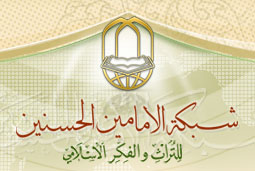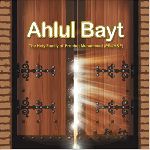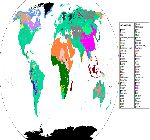Various Articles
Kumayt al-Asadi: The Great Revolutionary Shi'ite Poet
- Published at

Al-Farazdaq said: "Al-Kumayt was the poet of the first and the last. 'Ukrima al-Dabbi said: "Were it not for his poetry, there would be no translator for the language nor would there be a tongue for explanation.
Arabic Language and Shi'ites
- Published at
 The first one to fourmulate the principles of syntax in Arabic, according to concurrence of opinions of scholars, was Amir-ul-Mu'minin Imam Ali ibn Abu Talib(A.S.). He gave the basic idea to Abul Aswad Ad-Du'ili, (Zalim Bin 'Amr) who was one of the prominent.
The first one to fourmulate the principles of syntax in Arabic, according to concurrence of opinions of scholars, was Amir-ul-Mu'minin Imam Ali ibn Abu Talib(A.S.). He gave the basic idea to Abul Aswad Ad-Du'ili, (Zalim Bin 'Amr) who was one of the prominent.
The Differences Between English and Arabic
- Published at
-
- Source:
- www.esl.fis.edu
 Introduction: Arabic is the official language in many countries, including Egypt, Iraq, Libya, Saudi Arabia and Morocco. Arabic is also the language of the Koran, so Muslims of all nationalities, such as Indonesians, are familiar with it. There are many Arabic dialects, but there is one version that is taught in schools and used by the media across the Arab world.
Introduction: Arabic is the official language in many countries, including Egypt, Iraq, Libya, Saudi Arabia and Morocco. Arabic is also the language of the Koran, so Muslims of all nationalities, such as Indonesians, are familiar with it. There are many Arabic dialects, but there is one version that is taught in schools and used by the media across the Arab world.
Quick List of Common Literary Terms
- Published at
-
- Source:
- www.nw.rock-hill.k12.sc.us
 (Terms most applicable to AP Literature are in bold.)
Abstract Language-Language describing ideas and qualities rather than observable or specific things, people, or places. The observable or "physical" is usually described in concrete language.
(Terms most applicable to AP Literature are in bold.)
Abstract Language-Language describing ideas and qualities rather than observable or specific things, people, or places. The observable or "physical" is usually described in concrete language.
Medical Poetry in the Arabic Tradition: A Glimpse
- Published at
-
- Author:
- Rosanna Gorini
 Summary:
In the Arabic literature, didactic verse was a mnemotecnic device for easily remember basic concepts. For this reason verses were used in many medical treatises. In this paper some medical poems will be considered, with particular regard to ibn Sina’s Urjuza fi al tibb (Poem on medicine)
Key words: Arabic medical poetry, didactic poem, rajaz verse, Ibn Sinā,
Summary:
In the Arabic literature, didactic verse was a mnemotecnic device for easily remember basic concepts. For this reason verses were used in many medical treatises. In this paper some medical poems will be considered, with particular regard to ibn Sina’s Urjuza fi al tibb (Poem on medicine)
Key words: Arabic medical poetry, didactic poem, rajaz verse, Ibn Sinā,
Why Mecca?
- Published at
-
- Source:
- http://www.manuscript-cultures.uni-hamburg.de/mom/2012_09_mom_e.html
 The Dalāʾil al-ḫayrāt is one of the most important and widespread Islamic prayer collections. It is well known from Morocco, where it was composed, to as far as Southeast Asia and there are several thousand manuscripts existing worldwide which contain this work. The Munich Codex dated 1857, but also several other manuscripts and various printed editions show, after a general introduction, a two-sided illustration of the Islamic holy cities of Mecca and Medina. Manuscripts of this kind are the result of a longer development which started with non-illustrated manuscripts of the Dalāʾil al-ḫayrāt. But why are the illustrations showing both Mecca and Medina although Mecca is not the subject matter of the prayer collection at all?
The Dalāʾil al-ḫayrāt is one of the most important and widespread Islamic prayer collections. It is well known from Morocco, where it was composed, to as far as Southeast Asia and there are several thousand manuscripts existing worldwide which contain this work. The Munich Codex dated 1857, but also several other manuscripts and various printed editions show, after a general introduction, a two-sided illustration of the Islamic holy cities of Mecca and Medina. Manuscripts of this kind are the result of a longer development which started with non-illustrated manuscripts of the Dalāʾil al-ḫayrāt. But why are the illustrations showing both Mecca and Medina although Mecca is not the subject matter of the prayer collection at all?
Prophet Hazrat Moosa (a.s.) and Qaarun
- Published at
-
- Author:
- Fatima Zabeth Beenesh
 Qaarun was one of the seventy people who went to the Mount Sinai with the Moosa a.s. At the beginning he was poor, penniless and needy. Then the Almighty God bestowed him affluence to test him and he acquired huge and limitless money. He was well aware of the science of alchemy and with the ability of this knowledge he possessed many treasures and appointed 40 strong and powerful men to take care and operate the keys of his treasures. Qaarun occupied such a status that he brought the whole tribe of Bani Israil under his control.
Qaarun was one of the seventy people who went to the Mount Sinai with the Moosa a.s. At the beginning he was poor, penniless and needy. Then the Almighty God bestowed him affluence to test him and he acquired huge and limitless money. He was well aware of the science of alchemy and with the ability of this knowledge he possessed many treasures and appointed 40 strong and powerful men to take care and operate the keys of his treasures. Qaarun occupied such a status that he brought the whole tribe of Bani Israil under his control.
The Spatial Arts
- Published at
-
- Author:
- Isma'il R.al-Faruqi
 This expression is inclusive of a number of creative efforts and products of the Muslim peoples, which have so many features in common as to make their conjoined treatment more suitable than an isolated presentation of each art form.
This expression is inclusive of a number of creative efforts and products of the Muslim peoples, which have so many features in common as to make their conjoined treatment more suitable than an isolated presentation of each art form.
- «
- Start
- Previous
- 1
- Next
- End
- »


